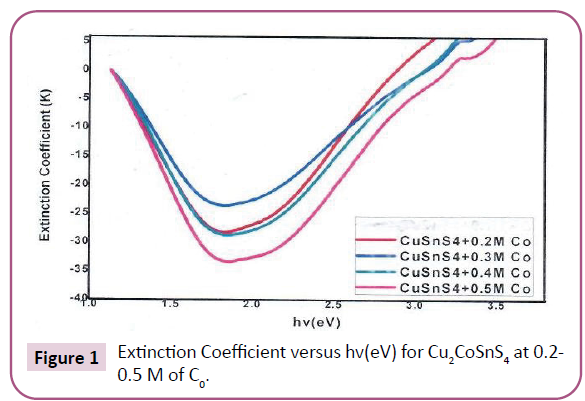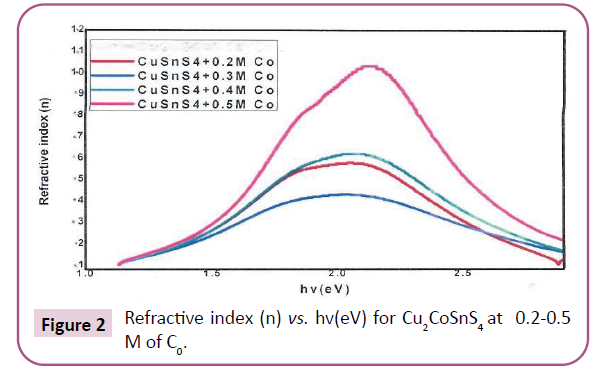Research Article - (2021) Volume 12, Issue 9
Daniel U Onah*1 and John E Ekpe2
1Department of Physics, Alex Ekwueme Federal University, Ndufu Alike Ikwo, Nigeria
2Department of Industrial Physics, Ebonyi State University, Abakaliki, Nigeria
*Corresponding Author:
Daniel U Onah
Department of Physics
Alex Ekwueme Federal University
Ndufu Alike Ikwo
Nigeria.
E-mail: d_onah@yahoo.co.uk
Received Date: September 11, 2021; Accepted Date: October 18, 2021; Published Date: October 25, 2021
Citation:Onah DU , Ekpe JE (2021) Optical Properties of Kesterite Cu2CoSnS4 Thin Film Solar Cells. Adv App sci res Vol.12 No.9:41
Kesterite Cu2CoSnS4 thin film solar cells were synthesized and deposited on glass substrates at a bath temperature of 343K for 5 hours. The structural and optical properties of the films were studied using X-ray diffraction analysis and spectrophotometer measurements in the wavelength range from 400 – 1000nm i.e. within the ultraviolet, visible and NIR regions of electromagnetic spectrum. Our interests in this paper are on the effects of the concentrations of the precursor on the extinction coefficients and refractive indices of the thin films. The concentrations of cobalt (Co) had no defined relationships with the refractive indices of the film samples. Nevertheless, since the refractive indices of the film samples with cobalt concentrations of 0.2 – 0.4 M are 0.541, 0.40 and 0.60 (which are below unity) respectively, these samples are good candidates for solar cells, as they are very good absorbing materials. The extinction coefficients are very low within the UV, visible and NIR regions of electromagnetic spectrum.
Keywords
Kesterite; Concentration; Extinction coefficients; refractive indices
Introduction
The first silicon solar converter was invented in 1953 at Bell laboratories and later in 1954, a description of 6% efficient, stable Si solar cell was published Fahrenbruch A, et al. [1]. The three main types of photovoltaic converters or solar cells are thin film solar cells, single crystal cells and concentrating systems [1,2]. Copper indium diselenide (CuInSe2) with a band gap of 1eV, is one of the chalcopyrites, that has proved to be a leading candidate for photovoltaic applications as a solar cell with excellent junction (with an absorption coefficient of 3 – 6 x 105 cm–1) [3]. Thin film solar cells are cells that have been deposited on electrically active or passive substrates such as glass, plastic, ceramic, metal, graphic or metallurgical silicon and examples of these thin films include CdS, Si, GaAs, InP, CdTe, CdO, TiO2 and kesterites like Cu2ZnSnS4 etc [4,5]. The main advantages of thin film solar cells are; the use of relatively low cost materials and their depositions require simple inexpensive techniques [6]. There are various thin films that are considered as potential candidates for absorber materials of solar cells due their band gap energy range of 1.0 to 2.0 eV [7]. Most of these thin films include the chalcogenide thin films such as SnS, SnSe, PbS, CoS and CdSe etc. Another set of thin films that has received great interest of many scholars is the ternary thin films. Ternary thin films of copper antimony sulphide (CuSbS2), iron zinc sulphide (FeZnS2), cadmium zinc sulphide (Cd1-xZnxS) for various applications have been deposited on glass substrates using different techniques like chemical bath deposition (CBD), spray pyrolysis and molecular beam epitaxy [1,8]. Further developments in photovoltaic devices have been reported in the literature on the synthesis, characterization, properties and applications of kesterites; copper zinc tin sulphur selenium Cu2ZnSn (SxSe1-x)4, (CZTSSe) and copper zinc tin sulphur Cu2ZnSnS4 (CZTS), thin film solar cells [5,9]. Kesterites are sulphide mineral with zinc rich variety whereas the zinc poor variety is known as ferrokesterites [10]. They can easily be deposited on glass substrates using many deposition techniques that can also be used in the deposition of chalcogenide and ternary thin films. There has been a fast increase in the advancement of photovoltaic and optoelectronic devices in recent times, especially in the less expensive thin film solar cells with relatively high efficiencies. Thin film solar cells such as cadmium selenide (CdSe) with Metal Insulator Structure (MIS) and kesterite thin film solar cells are attracting great interests in this regard. They offer very interesting new prospects for the development of thin film solar cells [2,5]. In this study we report on the effects of the concentrations of the precursor on the extinction coefficients and refractive indices of the kesterite Cu2CoSnS4 thin film solar cells. The extinction coefficient is defined as the degree or extent an external electromagnetic disturbance travelling with the velocity of light in vacuum is exactly cancelled out and replaced in the substance by the secondary disturbance travelling with an approximately smaller velocity [11]. It is the fractional decrease in intensity per wavelength. The absorption coefficient (α) expressed in terms of extinction coefficient (k) is given in equation (1), as:
 (1)
(1)
Where f is frequency and c is the velocity of light in vacuum. Since c equals f, k can be expressed in terms of π as given in equation (2) [12].
 (2)
(2)
The refractive index (n) of a non-magnetic or dielectric material is obtained from the direct result of Maxwell equations as given in equation (3).
 (3)
(3)
Where εr is the dielectric constant of the material [13].
Materials and Methods
Before the deposition, the glass substrates were cleaned with detergent, followed by another cleaning with dionised water, followed by using ammonia acid and finally rinsed with acetone. This substrate preparation was done in order to ensure uniform coating and also break the bond between the substrates and contaminants. This completely removed the effects of the contaminants on the properties of the thin films such as morphology and nucleation etc [14]. The chemical bath deposition technique was used in the deposition of kesterite Cu2CoSnS4 thin film solar cells, on glass substrates. In the synthesis of the thin film cobalt (Co) concentrations were varied from 0.2 – 0.5 M in steps of 0.1 M. The bath temperature was 343 K (70°C). The chemicals used include: Copper sulphate (CuSO4. 5H2O), cobaltous chloride (CoCl2.6H2O). Tin sulphate (SnCl¬2. 2H2O), thioacetemide (C2H2N2S) and the complexing agent was ammonia (NH3).
Thin film characterization
Spectrophotometer analysis for the thin films was done at the Centre for Energy and Research Development (CERD) in Obafemi Awolowo University (OAU), Ile Ife, Osun State, Nigeria. UVVis spectrophotometer was used in obtaining the optical and solid state properties of these thin films such as absorbance, transmittance, refractive indices and extinction coefficients etc. XRD, RBS and SEM analyses were also done but they are not included in our interest in this paper.
Results and Discussion
Extinction coefficient (k)
The extinction coefficient like the refractive index is one of the macroscopic optical constant though; it is not really constant because it varies with frequency [15]. The graph of extinction coefficient vs. photon energy at 0.2 – 0.5 M of Co is shown in Figure 1. Extinction coefficient shows how an external electromagnetic disturbance travelling with the velocity of light in vacuum is exactly cancelled out and replaced in the substance by the secondary disturbance travelling with an approximately smaller velocity, so that the wave intensity falls off [11]. The graph of extinction coefficient against photon energy is shown in Figure 1. In the NIR region, (hν 1.0-1.5eV) from Figure 1, the extinction coefficient (k) for each thin film sample decreased sharply from zero to; –20, –13, –15 and –20 for the samples at 0.2 – 0.5M of Co. This showed that k is not an explicit function of cobalt concentrations in the thin films. In the visible region, (hν=1.5-2.5eV), the values of k have sharp decrease and later increased to maximum values of; –13, –13, –18 and –21 for the four samples at 0.2 – 05M of Co, respectively. In the UV region, (hν=2.5-3.3eV) the values of k for all the thin film samples increased sharply to a maximum value of 5 each, in Figure 1. The low values of k for all the samples of the thin films are clear indications that the Cu2CoSnS4 thin film solar cell is a very good absorber of electromagnetic radiations.

Figure 1: Extinction Coefficient versus hv(eV) for Cu2CoSnS4 at 0.2- 0.5 M of C0.
Refractive index (n)
The refractive index of a material is defined as:
 (4)
(4)
Where c is the speed of light in vacuum, v is the speed of light in the material, k is wave number and ω is the angular frequency. It is an index that indicates how faster light travels in a vacuum than it do in the given material [13]. Any absorbing material has a complex refractive index n* given or expressed in equation (5); as:
n* = n − ik (5)
Where k is the extinction coefficient and n is real part of the complex refractive index [12, 13]. The imaginary part takes care of attenuation while the real part accounts for refraction. The graphs of refractive indices vs. photon energy for Cu2-CoSnS4 at 0.2 – 05M of cobalt are shown in Figure 2.

Figure 2: Refractive index (n) vs. hv(eV) for Cu2CoSnS4 at 0.2-0.5 M of C0.
In Figure 2, the refractive indices of all the thin film samples were very low (n <0.3) in the NIR, (hν=1.5-2.5eV). In the visible region, (hν=1.5-2.5eV) the maximum values of the refractive indices of the thin film samples with 0.2 – 0.5M of Co were determined as: 0.55, 0.40, 0.60 and 1.01. These values of the refractive indices of Cu2CoSnS4 thin films are much less than 1.08 and 1.05 values of refractive indices of SiO2 thin film samples as reported by other scholars [16]. Nevertheless, the maximum value of the refractive index determined in this study for the thin film sample with the cobalt concentration of 0.5 M, is not significantly different from the values of refractive indices of 1.05 and 1.08 obtained for TiO2 and SiO2 respectively by other scholars [17]. The refractive indices did not have a defined relationship or variation with the cobalt concentration in this region or spectrum of electromagnetic radiation. In this study, it is obvious that refractive index is a function of frequency or photon energy (hυ). In the UV region (hν >2.5eV), the refractive indices for all the samples were below 0.40. The low values of the refractive indices implied that Cu2CoSnS4 thin film is an excellent absorber of solar radiation and is therefore suitable for photovoltaic applications. It is also suitable for other applications in optical devices, such as optical microresonators and light emitting diodes [10,17].
Conclusion
Kesterite Cu2CoSnS4 thin film solar cells have been deposited on glass substrates using the chemical bath deposition method, at a bath temperature of 343K. The film samples have very low values of extinction coefficients ranging from –21 to –13, whereas the refractive indices have values ranging from, 0.40 to 1.01. These optical parameters or properties of the thin films make them very suitable for applications in optical devices such as photovoltaic cells and optical microresonators.
Acknowledgments
We gratefully appreciate the suggestions and encouragements of G.A. Agbo, S.I. Nworie and E.H Uguru.